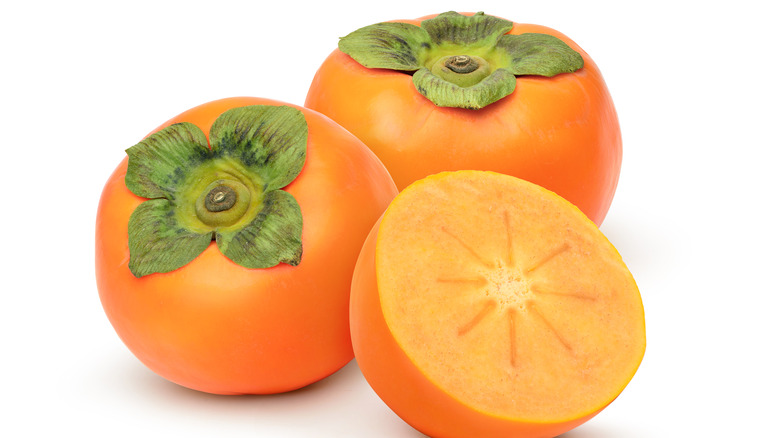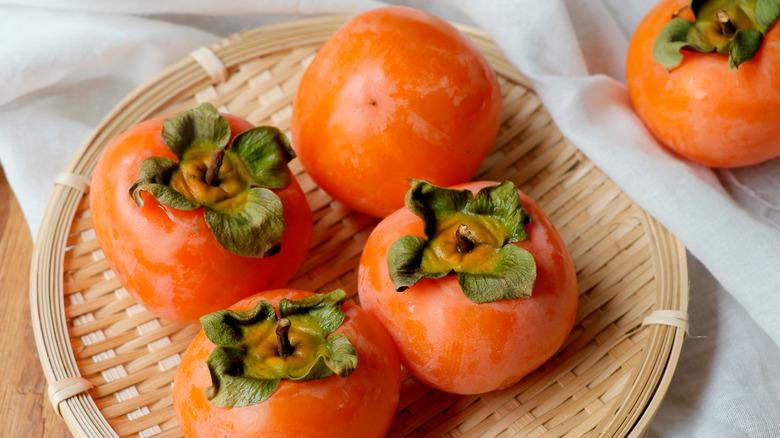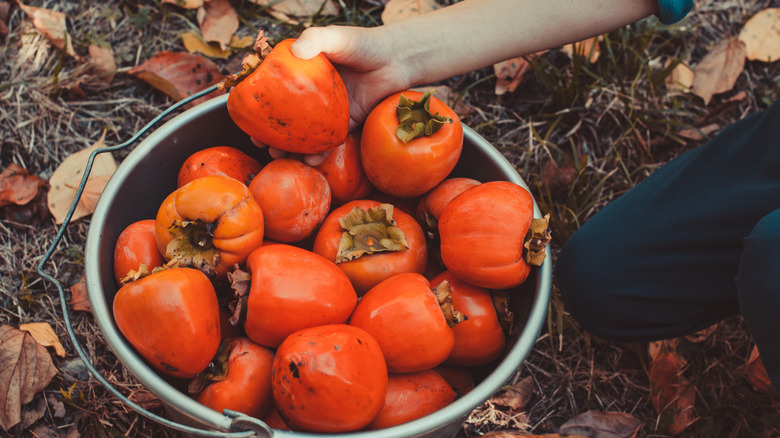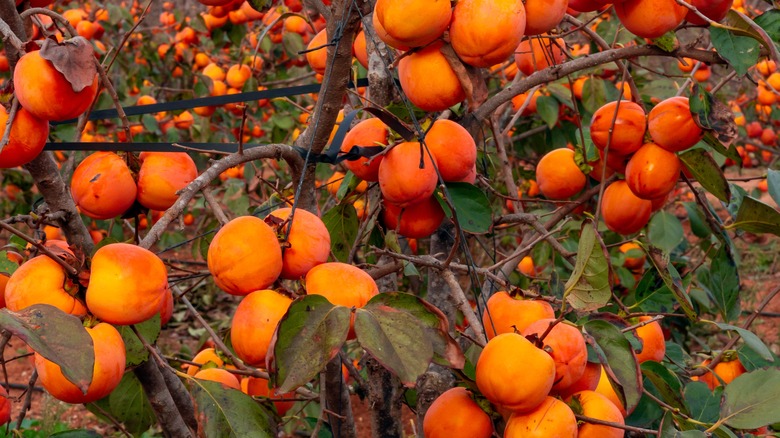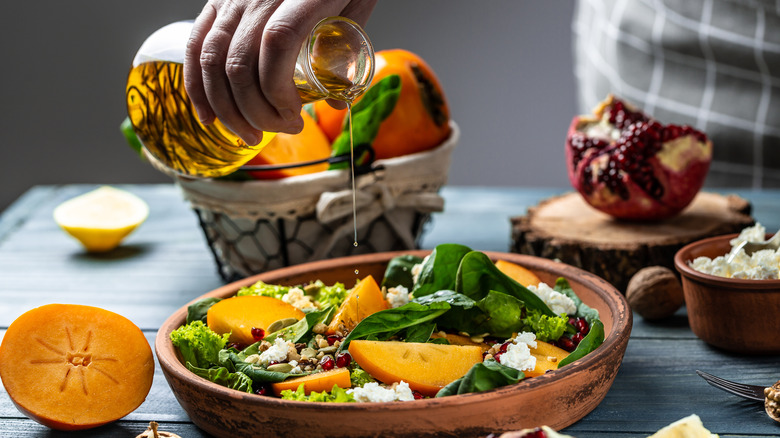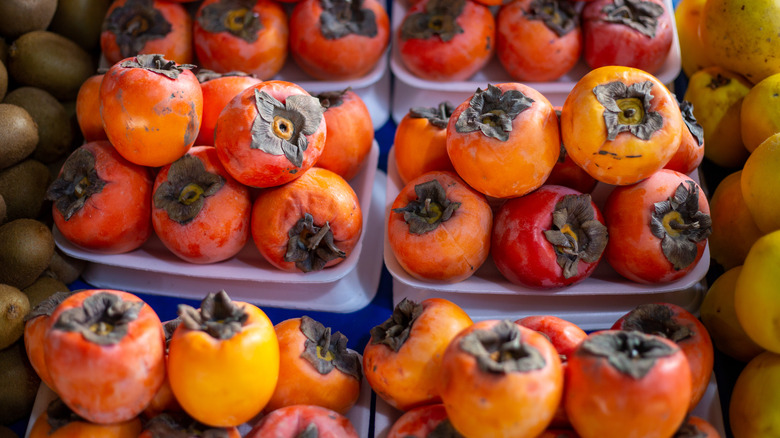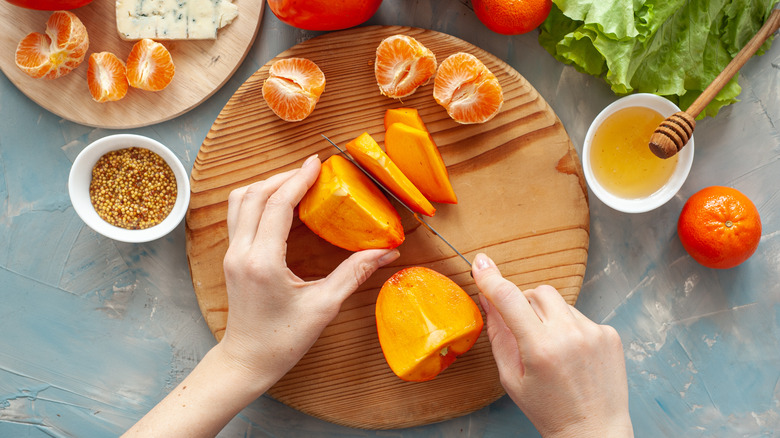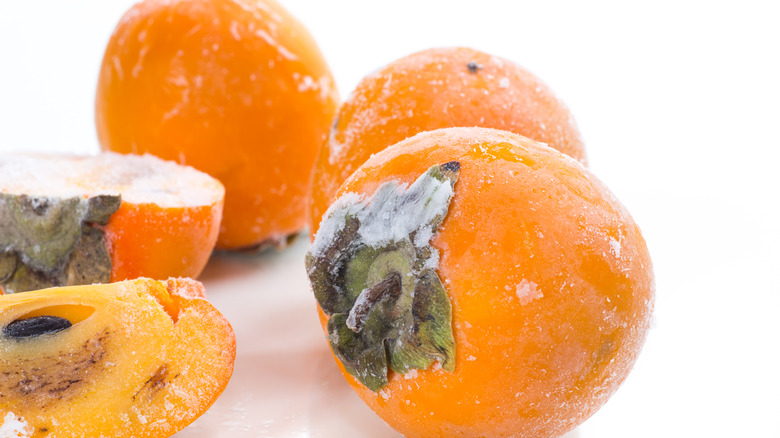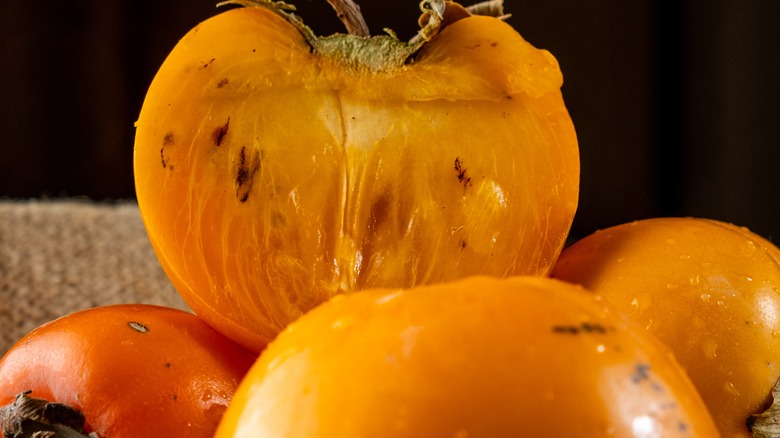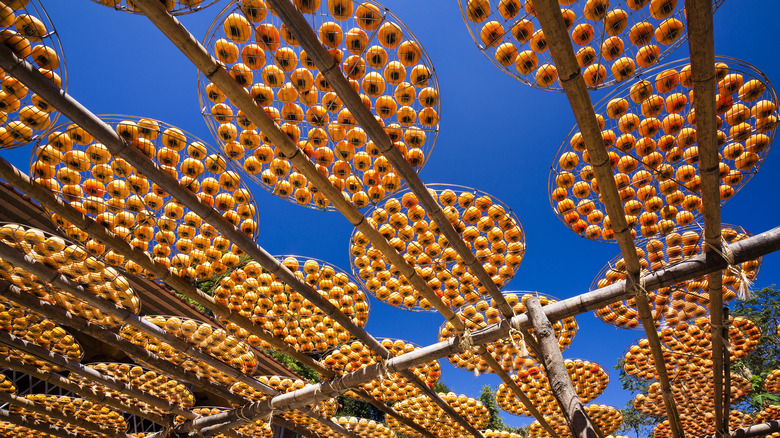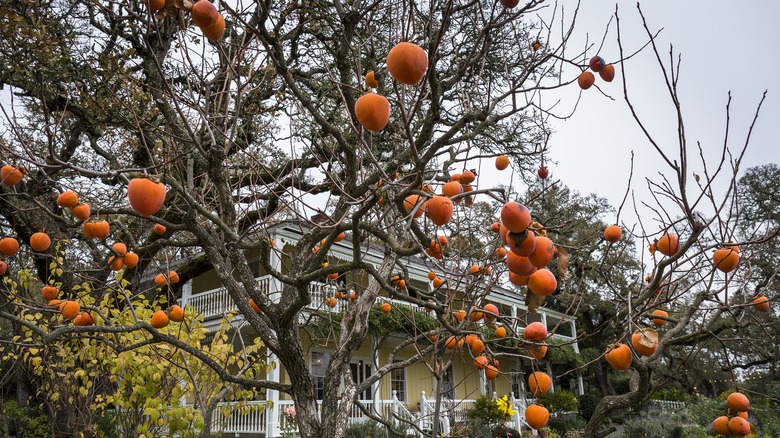Persimmon: Everything You Need To Know
A classic fall fruit, persimmons is an underrated treat that should be getting all the hype it deserves. These reddish-orange and plump fruits are the perfect welcome to fall with their sweet and zesty flavor coupled with notes of cinnamon. While persimmons are a popular autumn fruit in Japan, China, and Korea, they are relatively less heard of in the States.
But with the range of uses that persimmons come with — from jams to pies, marmalades, puddings, salad topping, and toasted spread — persimmon is gradually giving the good ol' pumpkin a run for its money. Not to mention that since persimmons are loaded with health benefits, they are popularly known as the "Fruit of the Gods" (via Proactive Health Labs). So, what in the world is a persimmon, what do they taste like, and where can you go looking for one? Without further ado, let's dig right into the world of persimmons.
Persimmons described
Shaped like a tomato on the outside, persimmons are orange-hued and sweet on the inside.
MasterClass notes that persimmons hail all the way from the Diospyros family. Capped with a green top, the fruit's color can vary from a vibrant yellow to rustic orange. Since the flesh changes color as it ripens, you may stumble upon light yellow to reddish-orange insides. Interestingly, even the tree leaves of persimmons have an orange tint.
The parental words of persimmon, pessamin, putchamin, or pasiminan have roots in the Powhatan language, and they all mean dry fruit.
Almost all persimmons have firm skin, but not all have seeds. Persimmon is specifically a berry with diverse varieties in shapes and sizes. Some are even shaped like a pumpkin, heart, or acorn. The Agricultural Marketing Resource Center differs between American and Asian persimmons by size. The American ones are plum-sized, but Asian persimmons are somewhat closer to a peach.
Such a unique flavor
Fresh, crisp, and clean, persimmons have a unique taste — and you probably cannot adequately describe them until you have eaten these beauties. Some say the taste is similar to common summer fruits, like a peach or an apricot. Others compare its sweetness to brown sugar, pear, or dates. The fruit's texture varies from jelly-like to peach-like.
You are better off avoiding an unripe persimmon since it can leave a bitter taste and give you cotton mouth (via American Restaurant). This is primarily because of tannins in the fruit, which causes your mouth to pucker as they coagulate your salivary proteins (via Walter Reeves).
However, fully ripened persimmons taste like absolute bliss, incredibly sweet yet zesty. Cooking Chew makes an interesting observation that while some varieties (Hachiya persimmons, for instance) have a honey-like sweetness, others are spicy like cinnamon. All in all, these round reddish-orange-hued beauties are rich, multi-flavored fruit with layers of deliciousness.
Origin of the persimmon
Persimmons have Asian roots, specifically in China and Japan. In fact, it's the national fruit of Japan. Post Magazine takes us through the persimmons' origins, reporting that it has been growing in China for over 10,000 years. The Han and Qin dynasties domesticated persimmon between 221 BC and 220 AD, and later dynasties cultivated it on a larger scale.
The fruit arrived in Japan in the 7th century. Americans should thank Admiral Perry, who discovered it on Japan's coast in 1851 and brought it to the United States. According to Ty Ty Plant Nursery, there were previously some unsuccessful attempts to grow persimmons in Washington DC.
Finally, the USDA's idea of using grafted Japanese cultivars allowed persimmons to blossom on American soil, notably in California and Georgia — that all began in 1870. The gorgeous trees were a public hit, blooming little yellow flowers and bearing fruit in the crisp Fall season. The Japanese Fuyu, Giant Fuyu, Eureka, Jiro, or Fuyugaki persimmon trees are a superb option for home gardens as well. During the 1900s cultivars were planted in Florida and became a huge hit "because of the prolific early bearing and the observation that the trees ripened into large crops of colorful, juicy fruit in late fall when very few fresh delicacies are available" (via Ty Ty Plant Nursery).
Health benefits
Persimmons aren't just delicious, they are also bursting with nutritional benefits. Persimmons are loaded with vitamin C, which can help fight inflammation and protect your body from free radical damage (per Healthline). Persimmons are also abundant in vitamin A, so your eye health will be in safe hands.
And that's not all. Persimmons are packed with magnesium, thiamin, phosphorus, and riboflavin. Riboflavin produces flavonoids, an antioxidant that can work wonders in helping decrease your heart risks and age-related mental decline (via National Library of Medicine)
WebMD goes one step further and notes that persimmons are packed with high amounts of soluble dietary fibers. These fibers can potentially prevent blood sugar spikes and improve digestion. Similarly, persimmon's tannin-rich fiber can lower cholesterol, making it great for cardiovascular disorders. Persimmons are also an excellent energy source since they're high in glucose and fructose (per EXCLI Journal).
A short season
Persimmons are tough to find. Since persimmons have an incredibly short season, you may not find them in your local grocery store. The Los Angeles Times reports that persimmons start popping up in October and last until January or February. This sweet yet spicy fruit comes right in time for autumn. If you are tired of eating the same ol' pumpkin pies for your fall dinners, consider whipping up a deliciously unique persimmon pie.
The Fuyu permissions are usually the first to arrive. The Japanese variety Hachiya comes a bit later, so they've had to soften up and reduce their astringency. You can always buy unripened Hachiya and allow them to soften at home.
As per Stark Bros, the best time to harvest persimmons is from September until the end of November. Stark Bros also notes that the fruit truly ripens after the season's first frost. While harvesting, use a shallow tray so you don't accidentally squish the bottom ones.
Ways to eat persimmons
When it comes to eating the non-astringent varieties, the Fuyu persimmon, they are best eaten when hard as apples. Simply cut off its leafy hat and enjoy it in slices. They also work well in salads. Chop them to your desired thickness and pair them with favorite fruits. Add some leafy greens, dressings, and viola! You'll have a refreshing salad to relish.
Adding them to charcuterie boards alongside cheese and grapes is also a superb way to enjoy eating persimmons. Another invigorating option is pairing diced persimmons with oatmeal or Greek yogurt for a power-packed breakfast.
As for the astringent varieties — Hachiya persimmon — they're best eaten when fully ripened and soft. They are too squishy to bite into and typically leave behind a mess. So it's best to cut it in half and scoop the juicy flesh like you would an avocado. You can also spread the fruit onto toast.
Another delicious way you can use the Hachiyas is cooked into jams and marmalades and baked into pies, puddings, and cakes. You can also blend them into your favorite smoothies. Keep in mind that the skin of a persimmon is edible — just make sure to wash the fruit before eating.
Staying fresh
Persimmons generally spoil quickly, depending on how you store them. The best way to keep the fruit is either by refrigerating or freezing them. You can put them in your fridge in open zipper bags or a cling wrap-covered bowl.
Even when kept in the fridge, a ripened persimmon won't last you more than a few days. Glad advises eating the stored persimmons within two to three days. PantryTips suggest ripe persimmons may last for nearly five days in the fridge. Make sure you keep them in the crisper container of your refrigerator.
You can also freeze whole or sliced persimmons, which can stay good for nearly six months. Try making a persimmon purée with 1 tablespoon of lemon juice to preserve it better. This can last you for around 10 to 12 months in the freezer.
Since unripened persimmons take a week to ripen, you can leave them at room temperature up to seven days, per Harvest to Table. Remember to turn the fruit to avoid over-ripening on one side continuously. You can also refrigerate unripened persimmons for a month. Ultimately the storing temperature and conditions of persimmon before you buy it vastly affect its shelf life.
Fuyu vs. Hachiya Persimmon
The most well-known varieties of persimmons in the United States are the Fuyu and Hachiya. So, how are they different?
For starters, Fuyu persimmons are far more common than its sibling, making up 80% of the persimmon market (via Gardensall). It is also seedless, more resilient, and has a flat bottom. You can enjoy Fuyu in its firm and unripened state. You might know Fuyu persimmons by their other name Fuyugaki. The best part about Fuyu persimmons is that they are incredibly sweet and don't leave your mouth all puckered up.
Conversely, Hachiya persimmons are best when fully ripened since they contain a high level of tannins in their unripened state which can leave a bitter aftertaste. So you better eat Hachiya when it is soft, almost jelly-like. Hachiya persimmons are also larger than Fuyu persimmons and more round in shape.
According to GrubMarket, Hachiya is acorn-shaped, whereas Fuyu resembles an orange tomato or pumpkin. Hachiya persimmons have a couple of big seeds but tend to be more orange. While the Fuyu ones are more yellow-toned. Whatever persimmon variety you opt for, both are equally delicious with a sweet yet tangy flavor and subtle hint of cinnamon.
Persimmons are celebrated annually
This juicy fruit is such a delicacy that it even has a festival celebrating its goodness. The persimmon capital of the world, aka Mitchell, Indiana, hosts the annual Mitchell Persimmon Festival in September.
My Indiana Home sheds light on its origin, noting that George Bishop, a local teacher, initiated the celebration back in 1947. Since then, the quaint town comes together annually and commemorates its abundantly grown persimmons. Word has it that the local persimmon recipes are protected like Fort Knox, but you might be able to enjoy them during the festivities. If you think the celebrations will only have persimmons for every meal, a whole feast of other foods proves otherwise. Enjoy persimmons and see how well it pairs with different dishes.
Usually, festivals last for a couple of days, but Mitchell folks take it up a notch to an entire week. So what do they do for seven days? Well, the merry locals travel back to the 1800s, dressing like their ancestors and immersing themselves in the vintage ways. Limestone Country shares some events, which include candlelight tours, parades, pageants, stalls, contests, and yard sales. Free concerts set the party mood, and thousands flock to the local town to celebrate the mighty fruit.
Food of the Gods
The scientific name of persimmons, Diospyros kaki, is loosely translated to 'Food of the Gods' with Dios meaning God and pyros meaning food (per The Epoch Times).
Perhaps this is why most people believe persimmons are a divine fruit. Given that persimmons are loaded with health benefits, the name definitely isn't without reason. These nutrition perks have also earned persimmon the title of superfood.
Gardens Project further states that persimmon's divine taste contributes to its worthy nickname. The honey-like sweetness sprinkled with a hint of spice offers a godly eating experience. What's more miraculous is that persimmon trees don't need pollination to grow the fruit. Most varieties are self-fertilized and bloom on their own. However, if persimmons are pollinated, the result is a bigger, juicier persimmon, albeit with seeds. Proactive Health Labs also shares other famous names of persimmons, including Nature's Candy, Jove's Fire, and The Apple of the Orient, among others.
Buying the best persimmons
Choosing the best persimmon variety may be tough with all the different types of varieties in the market, but the Los Angeles Times comes to the rescue — deep-colored persimmons is recommended. The darker the color, the better your chances of getting the finest ones. Some folks rely on a black streak dashing the Hachiya persimmons' skin. That usually signifies that the particular persimmon is delectably sweet.
The Guardian suggests picking firm persimmons to last you longer. If you do get an unripened one, you can store it with bananas. Ethylene released by bananas will speed up the ripening process of persimmons (via Science Focus). Just don't keep cut persimmons near bananas, or they will taste like bananas. Boston Magazine explains this is due to a compound called isoamyl acetate which can make everything taste like bananas if kept in close proximity to the fruit.
Another factor to keep in mind is persimmons don't appreciate extreme temperatures. That might turn them mushy, so better pick and store them at room temperatures.
